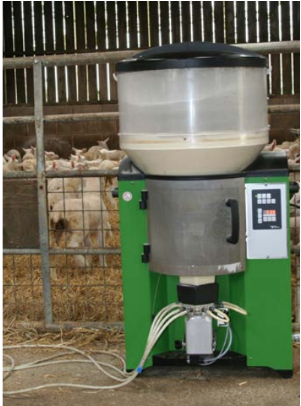Streamlining Efficiency with Computerised Lamb Feeding Systems
-

- 25 Jan 2024
- 0 Comments

These results from an online survey with 350 sheep producers, carried out by Volac, suggest that only half of the market is taking advantage of modern feeding and rearing technology to boost animal performance and make their life easier.
The research gives an interesting insight into current surplus lamb rearing practices. Not surprisingly, the lambs being reared artificially are those from triplet-bearing ewes in the main, along with any orphans.
Touching on the management surrounding triplet lambs, just under 80% of the farmers surveyed said they would remove one of the lambs and rear it artificially. While It can seem daunting moving to an automatic system for feeding lambs, especially as there has previously been a perception that surplus lambs are often not worth the investment. While automatic feeders may seem an expensive outlay, the investment pays you back year after year, with many farmers reporting better mortality rates for premature and weak lambs.
Depending on the number of surplus lambs on a sheep unit, newborns can be easily fed warm milk via a goodvalue teated bucket feeders, or reared automatically by a more sophisticated computerised feeder, which dramatically cuts the time spent mixing milk and feeding lambs. Milk is consumed little and often, which means faster growth rates and less risk of digestive upsets.
The computerised Volac ECO Feeder from Förster Technik can dramatically cut the time spent mixing milk and feeding. It feeds up to 240 lambs, but a high level of management and hygiene is essential.The easy-cleaning ECO Feeder automatically mixes a precise volume of milk powder to a consistent, specified temperature. The amount used across the milk feeding period is approximately 10-12kg per lamb. Milk may be offered warm (38°C) on a restricted basis during the early training period, but once lambs are sucking well from the teat on an ad-lib basis the milk temperature should be reduced to 18-20°C to reduce the risk of health problems caused by over consumption. The machine should be cleaned daily and calibrated at least once a week, and between batches of milk powder.
Benefits of an automatic machine feeding:
• Least labour-intensive surplus lamb feeding system. The machine automatically mixes and dispenses a consistent supply of milk replacer – no manual mixing is required.
• Milk is consumed little and often, which means less risk of digestive upsets.
• Delivers faster growth rates to traditional bottle feeding.
• No limit to how much, or when, lambs can drink.
Disadvantages of an automatic machine feeding:
• High set-up costs.
• Disease can potentially spread through shared teats, so
hygiene is paramount.












